Global Gridded Argo Dataset Based on Gradient-Dependent Optimal Interpolation
Abstract
:1. Introduction
2. Materials and Methods
2.1. Materials
2.1.1. Argo Observational Profiles
2.1.2. Auxiliary Materials
2.2. Objective Analysis System for Argo
2.2.1. Background Settings
2.2.2. Gradient-Dependent Optimal Interpolation
2.2.3. Pycnocline-Based Model
3. Results
3.1. GDCSM-Argo Information
3.2. Verification
3.2.1. Theoretical Verification
3.2.2. Comparisons against Other Gridded Argo Datasets
3.3. Application
3.3.1. Thermocline Characteristics
3.3.2. Global Sound Velocity
4. Discussion
5. Conclusions
Author Contributions
Funding
Institutional Review Board Statement
Informed Consent Statement
Data Availability Statement
Acknowledgments
Conflicts of Interest
References
- Argo Steering Team. On the Design and Implementation of Argo: An Initial Plan for a Global Array of Profiling Floats; International CLIVAR Project Office Report 21. GODAE Report 5; GODAE International Project Office: Melbourne, Australia, 1998; p. 32. [Google Scholar]
- Roemmich, D.; Johnson, G.C.; Riser, S.; Davis, R.; Gilson, J.; Owens, W.B.; Garzoli, S.; Schmid, C.; Ignaszewski, M. The Argo Program: Observing the global oceans with profiling floats. Oceanography 2009, 22, 34–43. [Google Scholar] [CrossRef] [Green Version]
- Wong, A.P.S.; Wijffels, S.E.; Riser, S.C.; Pouliquen, S.; Hosoda, S.; Roemmich, D.; Gilson, J.; Johnson, G.C.; Martini, K.; Murphy, D.J.; et al. Argo data 1999–2019: Two million temperature-salinity profiles and subsurface velocity observations from a global array of profiling floats. Front. Mar. Sci. 2020, 7, 1–23. [Google Scholar] [CrossRef]
- Johnson, G.C.; Hosoda, S.; Jayne, S.R.; Oke, P.R.; Riser, S.C.; Roemmich, D.; Suga, T.; Thierry, V.; Wijffels, S.E.; Xu, J. Argo-Two Decades: Global Oceanography, Revolutionized. Annu. Rev. Mar. Sci. 2022, 14, 379–403. [Google Scholar] [CrossRef]
- Levitus, S. Climatological Atlas of the World Ocean; US Department of Commerce, National Oceanic and Atmospheric Administration: Washington, DC, USA, 1982. [Google Scholar]
- Troupin, C.; Mach, F.; MachOuberdous, F.; Sirjacobs, D.; Barth, A.; Beckers, J.M. High-resolution climatology of the northeast Atlantic using data-interpolating variational analysis (Diva). J. Geophys. Res. 2010, 115. [Google Scholar] [CrossRef] [Green Version]
- Oke, P.; Brassington, G.B.; Griffin, D.A.; Schiller, A. The bluelink ocean data assimilation system (BODAS). Ocean Model. 2008, 21, 46–70. [Google Scholar] [CrossRef] [Green Version]
- Oke, P.; Brassington, G.B.; Griffin, D.; Schiller, A. Ocean data assimilation: A case for ensemble optimal interpolation. Aust. Meteorol. Oceanogr. J. 2010, 59, 67–76. [Google Scholar] [CrossRef] [Green Version]
- Hosoda, S.; Ohira, T.; Nakamura, T. A monthly mean dataset of global oceanic temperature and salinity derived from Argo float observations. JAMSTEC Rep. Res. Dev. 2008, 8, 47–59. [Google Scholar] [CrossRef] [Green Version]
- Roemmich, D.; Gilson, J. The 2004–2008 mean and annual cycle of temperature, salinity, and steric height in the global ocean from Argo program. Prog. Oceanogr. 2009, 82, 81–100. [Google Scholar] [CrossRef]
- Good, S.A.; Martin, M.J.; Rayner, N.A. EN4: Quality controlled ocean temperature and salinity profiles and monthly objective analyses with uncertainty estimates. J. Geophys. Res. 2013, 118, 6704–6716. [Google Scholar] [CrossRef]
- Liu, Z.H.; Li, Z.Q.; Lu, S.L.; Wu, X.; Sun, C.; Xu, J. Scattered Dataset of Global Ocean Temperature and Salinity Profiles from the International Argo Program. J. Glob. Change Data Discov. 2021, 5, 22–31. [Google Scholar]
- Bonekamp, H.G.; Oldenborgh, J.V.; Burgers, G. Variational assimilation of TAO and XBT data in the HOPE OGCM: Adjusting the surface fluxes in the tropical ocean. Geophys. Res. 2001, 106, 16693–16709. [Google Scholar] [CrossRef]
- Hollingsworth, A.; Lonnberg, P. The statistical structure of short-range forecast errors as determined from radiosonde data. Part I: The wind field. Tellus Ser. A-Dyn. Meteorol. Oceanogr. 1986, 38, 111–136. [Google Scholar] [CrossRef] [Green Version]
- Meyers, G.; Phillips, H.; Smith, N.; Sprintall, J. Space and time scales for optimal interpolation of temperature-Tropical Pacific Ocean. Prog. Oceanogr. 1991, 28, 189–218. [Google Scholar] [CrossRef]
- Zhang, C.; Xu, J.; Bao, X.; Wang, Z. An effective method for improving the accuracy of Argo objective analysis. Acta Oceanol. Sin. 2013, 32, 66–77. [Google Scholar] [CrossRef]
- Zhang, C.L.; Wang, Z.F.; Liu, Y. An Argo-based experiment providing near-real-time subsurface oceanic environmental information for fishery data. Fish. Oceanogr. 2021, 30, 85–98. [Google Scholar] [CrossRef]
- Zhang, C.L.; Wang, D.Y.; Wang, Z.F. Fishery analysis using gradient-dependent optimal interpolation. Acta Oceanol. Sin. 2022, 41, 116–126. [Google Scholar] [CrossRef]
- Yan, C.X.; Zhu, J.; Xie, J.P. An ocean reanalysis system for the joining area of Asia and Indian-Pacific ocean. Atmos. Ocean. Sci. Lett. 2010, 3, 81–86. [Google Scholar]
- Martin, M.J.; Hines, A.; Bell, M.J. Data assimilation in the FOAM operational short-range ocean forecasting system: A description of the scheme and its impact. Q. J. R. Meteorol. Soc. 2007, 133, 981–995. [Google Scholar] [CrossRef]
- Li, Z.Q.; Liu, Z.H.; Lu, S.L. Global Argo data fast receiving and post-quality-control-system. In IOP Conference Series: Earth and Environmental Science; IOP Publishing: Bristol, UK, 2020. [Google Scholar]
- Akima, H. A new method for interpolation and smooth curve fitting based on local procedures. J. ACM 1970, 17, 589–602. [Google Scholar] [CrossRef]
- Fofonoff, N.P.; Millard, R.C. Algorithms for Computation of Fundamental Properties of Seawater; UNESCO Technical Papers in Marine Sciences 44; UNESCO: Paris, France, 1983; pp. 3–59. [Google Scholar]
- Chu, P.C.; Fan, C. Maximum angle method for determining mixed layer depth from sea glider data. J. Oceanogr. 2011, 67, 219–230. [Google Scholar] [CrossRef]
- Riishogaard, L.P. A direct way of specifying flow-dependent background error correlations for meteorological analysis system. Tellus A 1998, 50, 42–57. [Google Scholar] [CrossRef]
- Gandin, L.S. Objective Analysis of Meteorological Fields; Gidrometeor Isdaty: Leningrad, Russia, 1963; p. 242. [Google Scholar]
- Kalnay, E. Atmospheric Modeling, Data Assimilation, and Predictability; Cambridge University Press: London, UK, 2003; p. 129. [Google Scholar]
- Zhang, C.; Xu, J.; Bao, X. Gradient dependent correlation scale method based on Argo. J. PLA Univ. Sci. Technol. 2015, 16, 476–483. [Google Scholar]
- Zhang, C.; Zhang, M.; Wang, Z.; Hu, S.; Wang, D.; Yang, S. Thermocline model for estimating Argo surface temperature. Sustain. Mar. Struct. 2022, 4, 1–12. [Google Scholar]
- Wang, X.; Cheng, L.; Zhang, C.; Li, H. Comparative Analysis of Global Applicability of Different Mixed Layer Depth Algorithms. Hai Yang Tong Bao, 2022; accepted. (In Chinese) [Google Scholar]
- Liang, F.Z. Applied Probability and Statistics; Tianjin University Press: Tianjin, China, 2004. [Google Scholar]
- Zhang, C.L. Research on Argo Data Re-Analysis Method and the Re-Construction of Argo Gridded Data Set. Ph.D. Thesis, Ocean University of China, Shandong, China, 2013. [Google Scholar]
- Leetma, A. The interplay of El Nino and La Nina. Oceanus 1989, 32, 30–34. [Google Scholar]
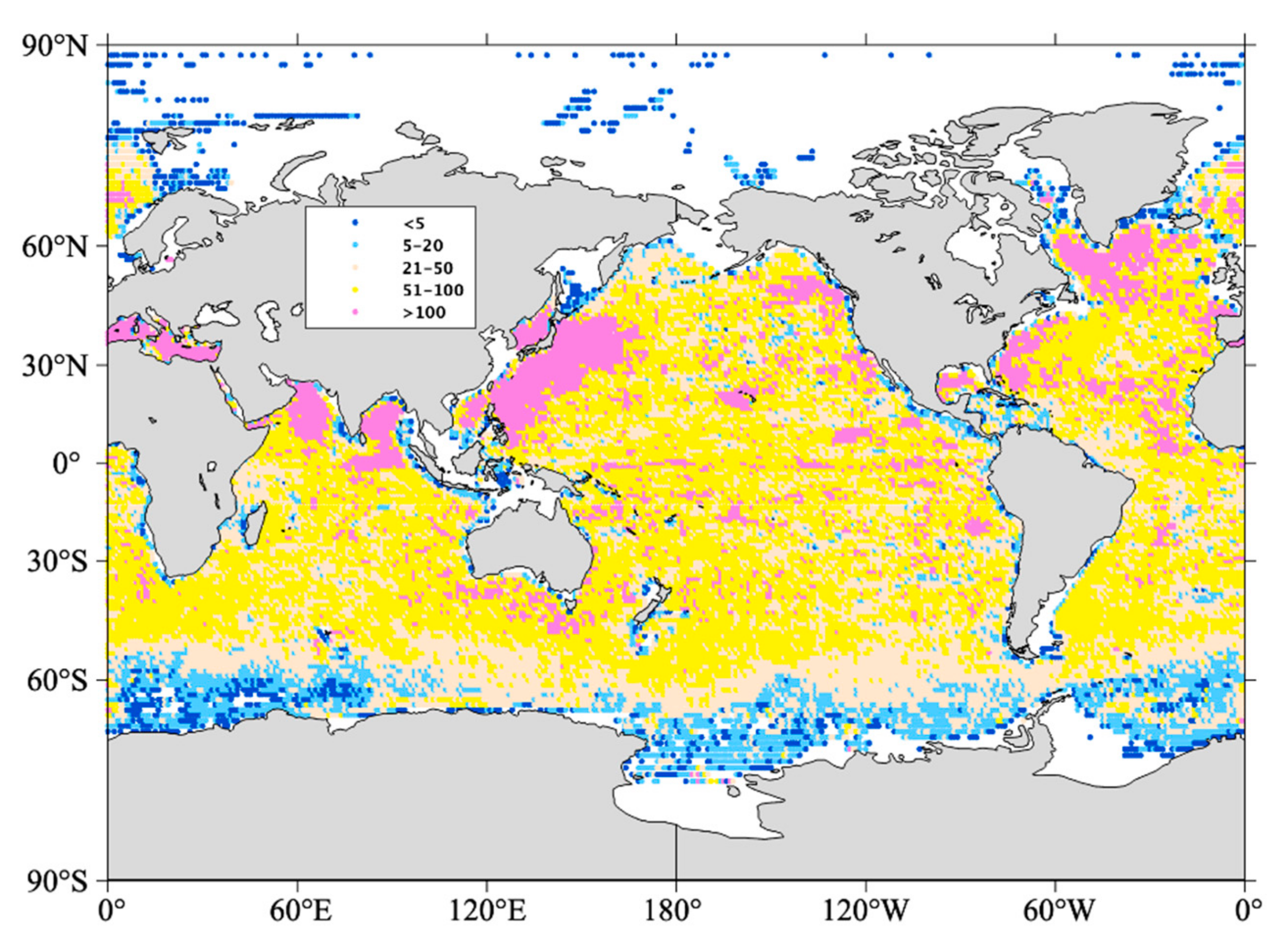
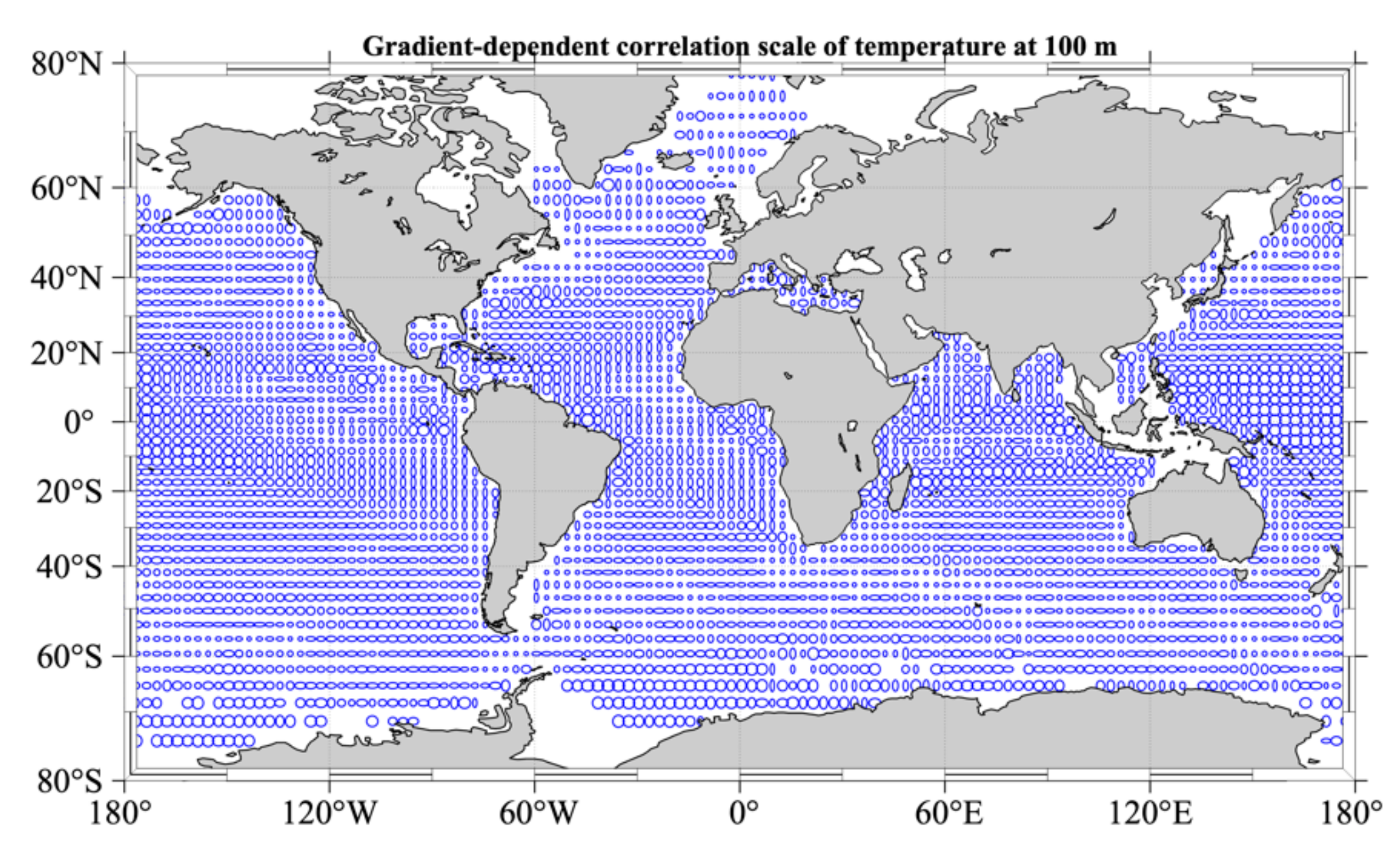
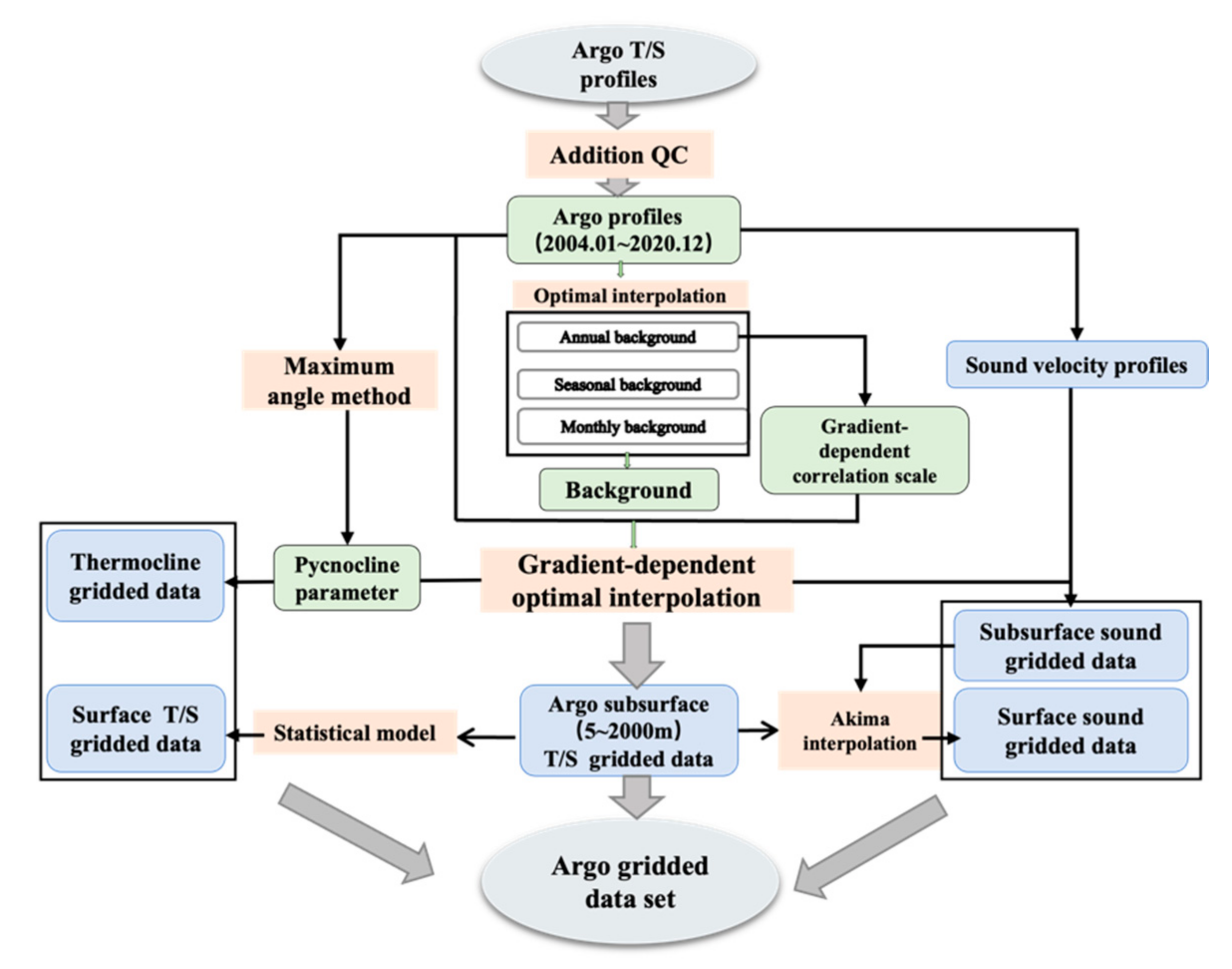
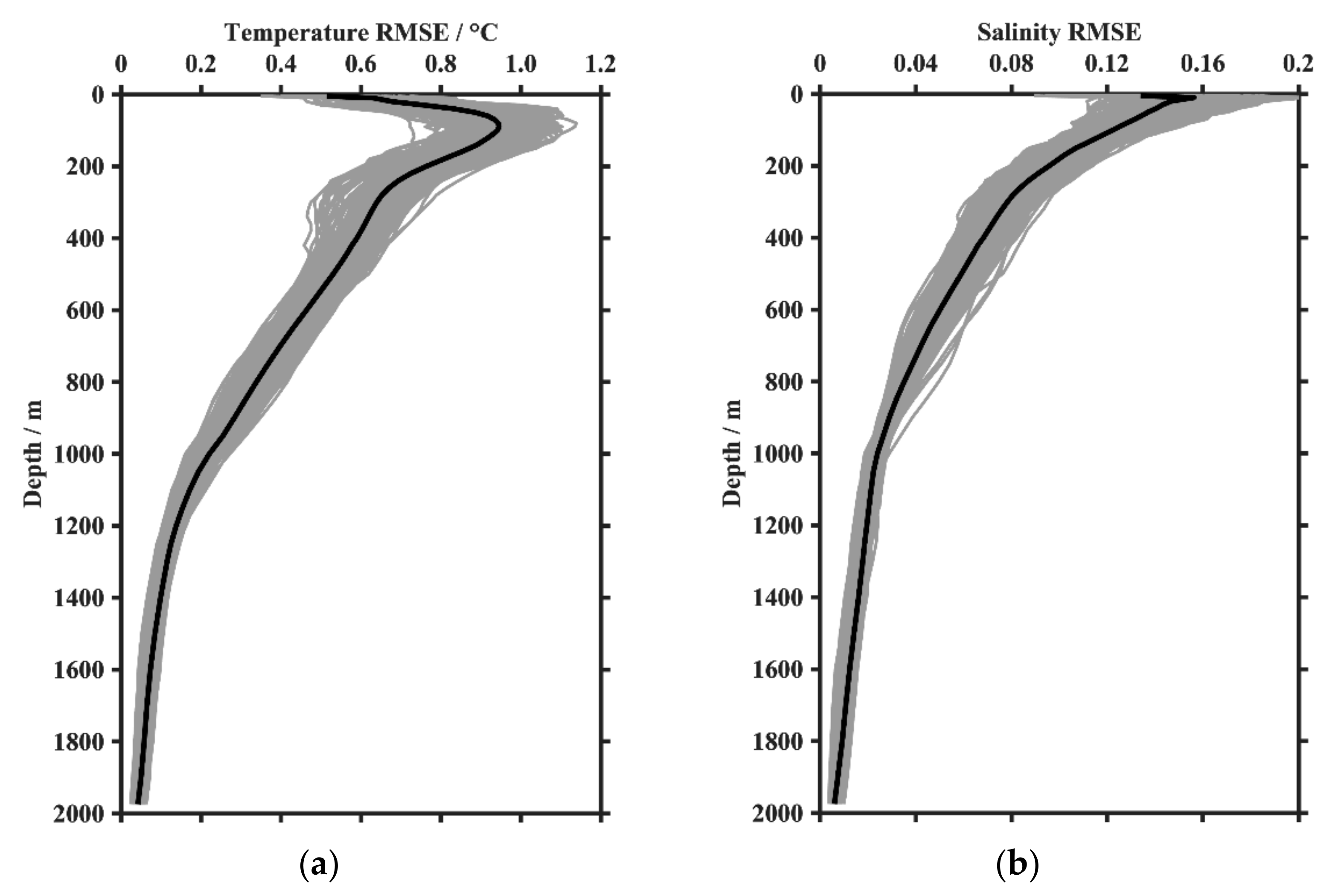



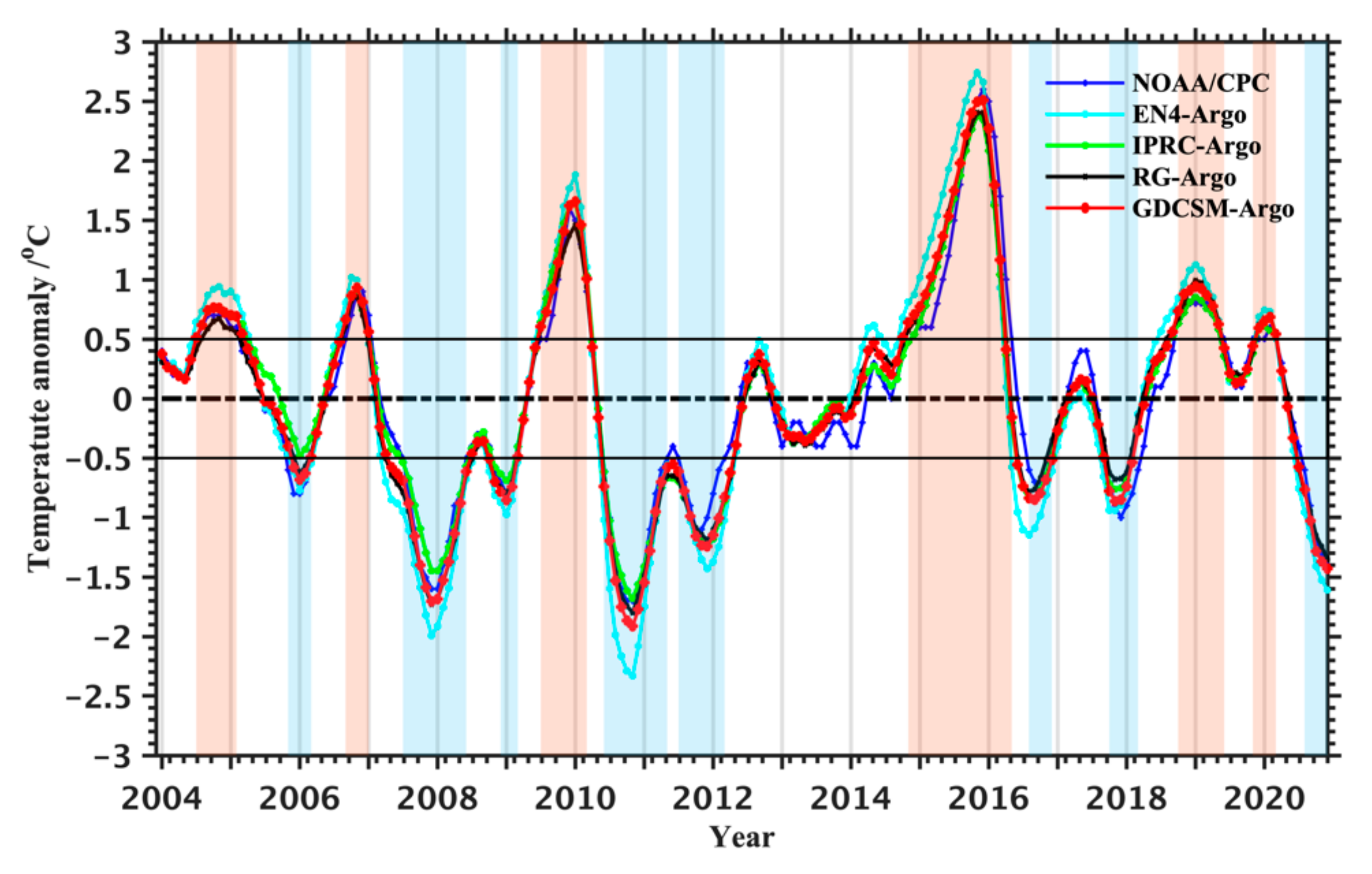
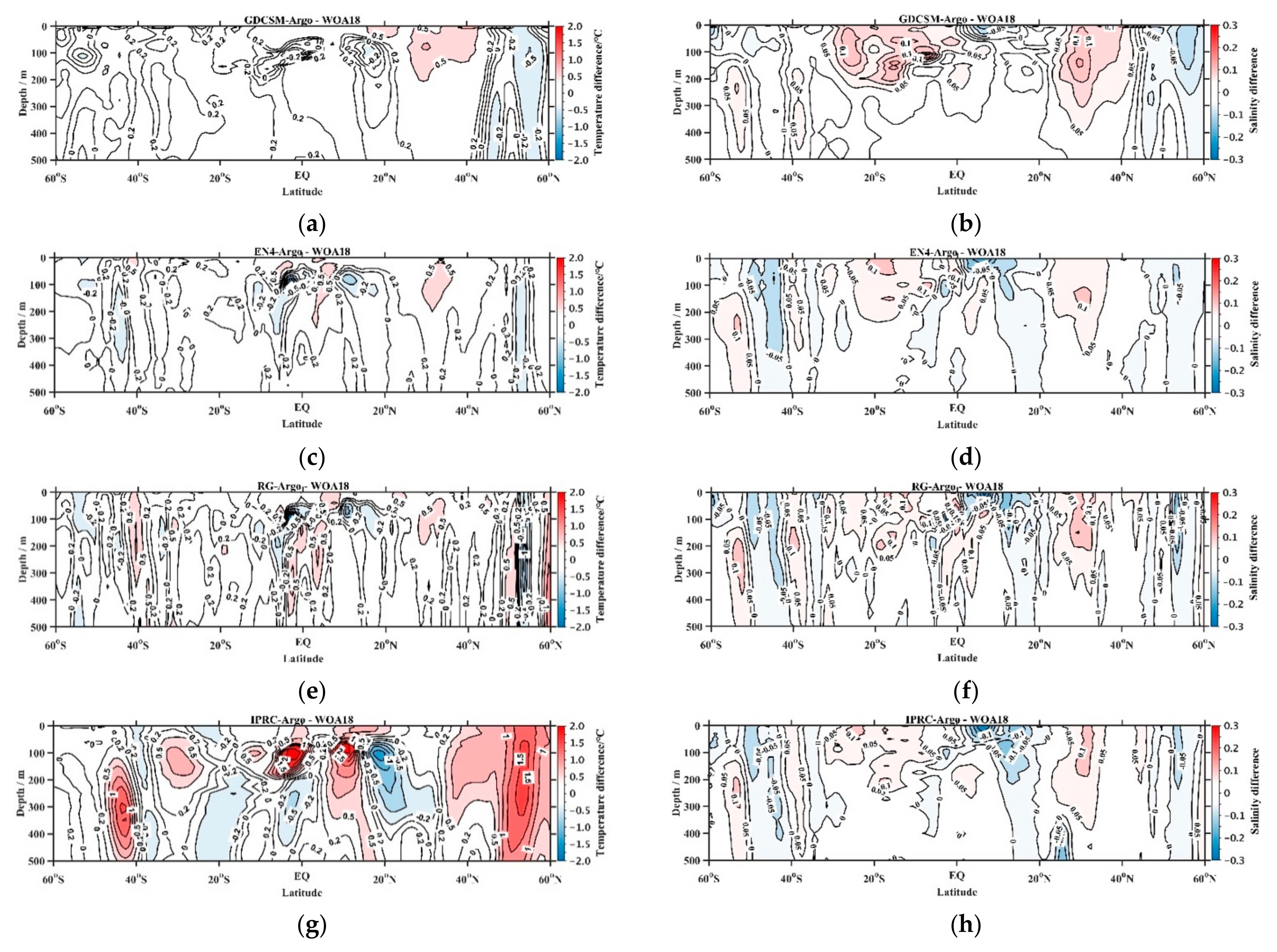

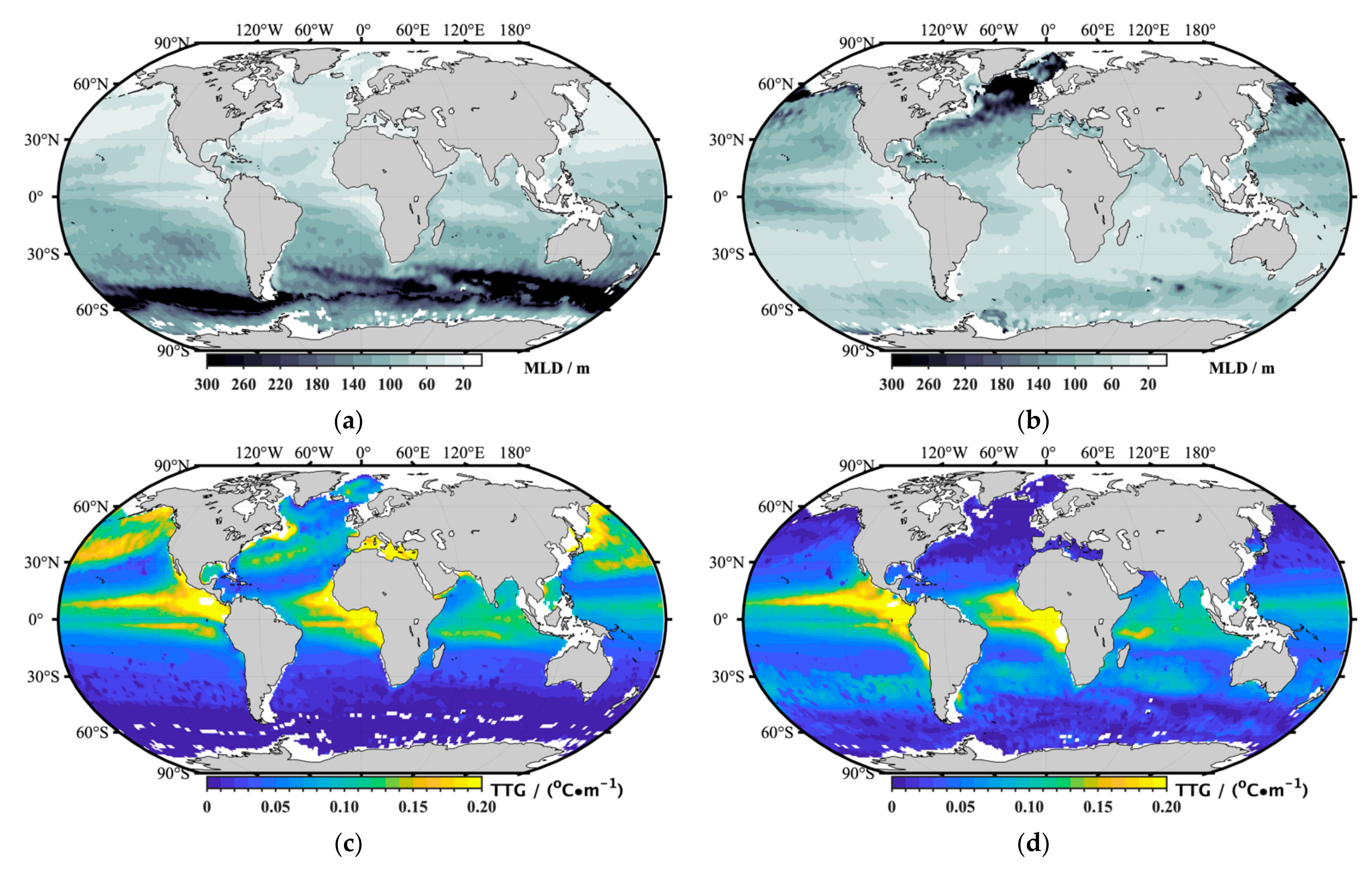

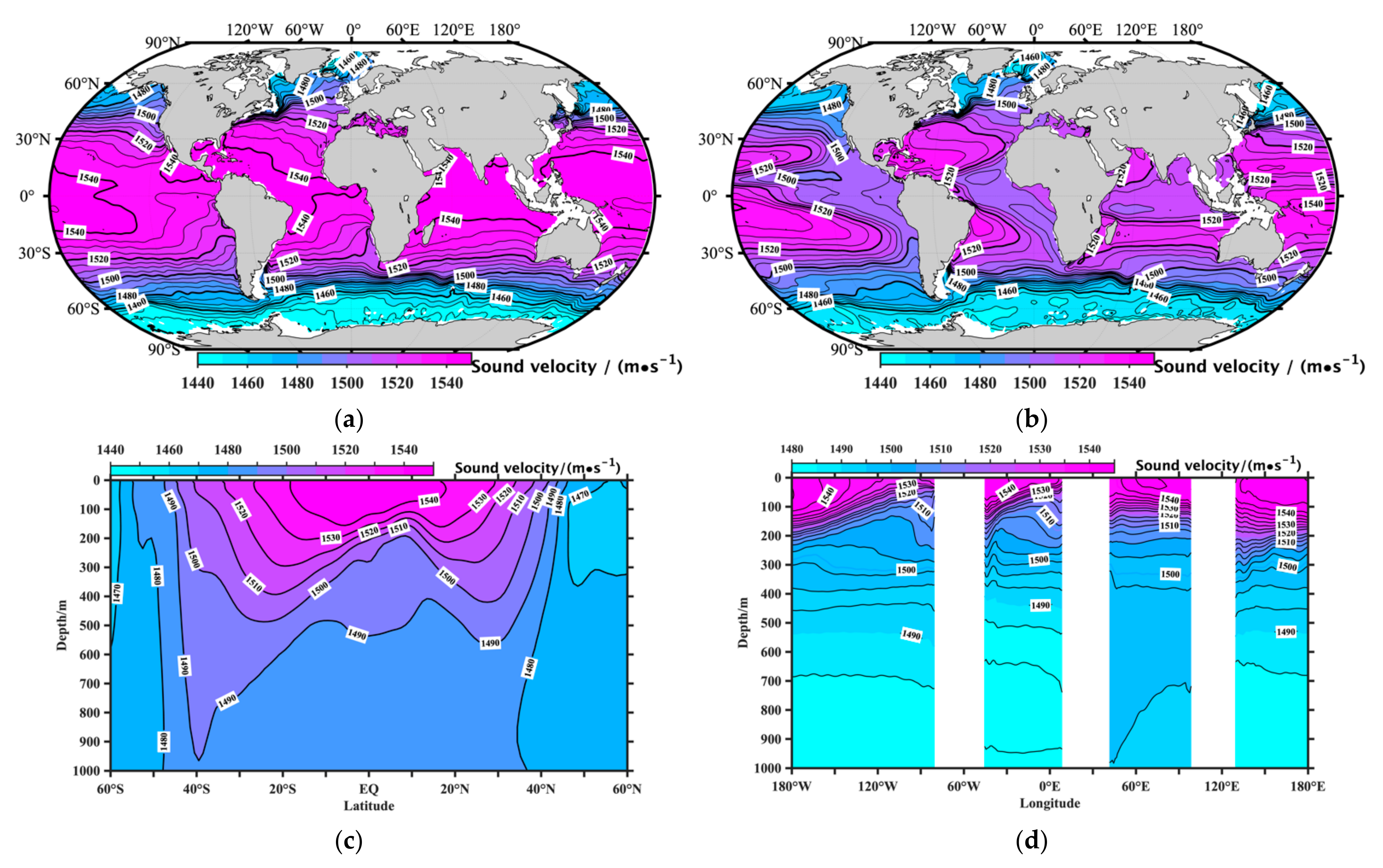
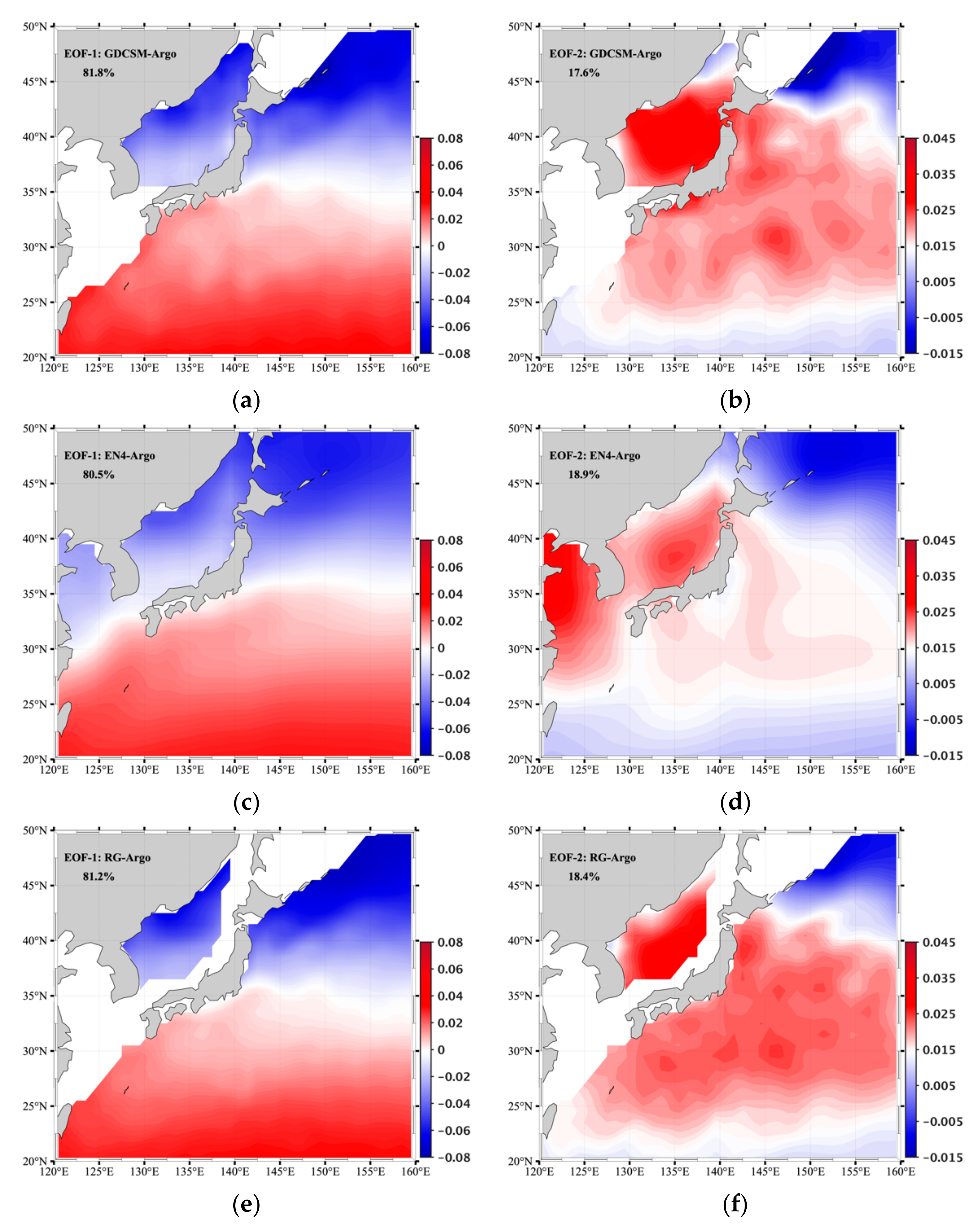
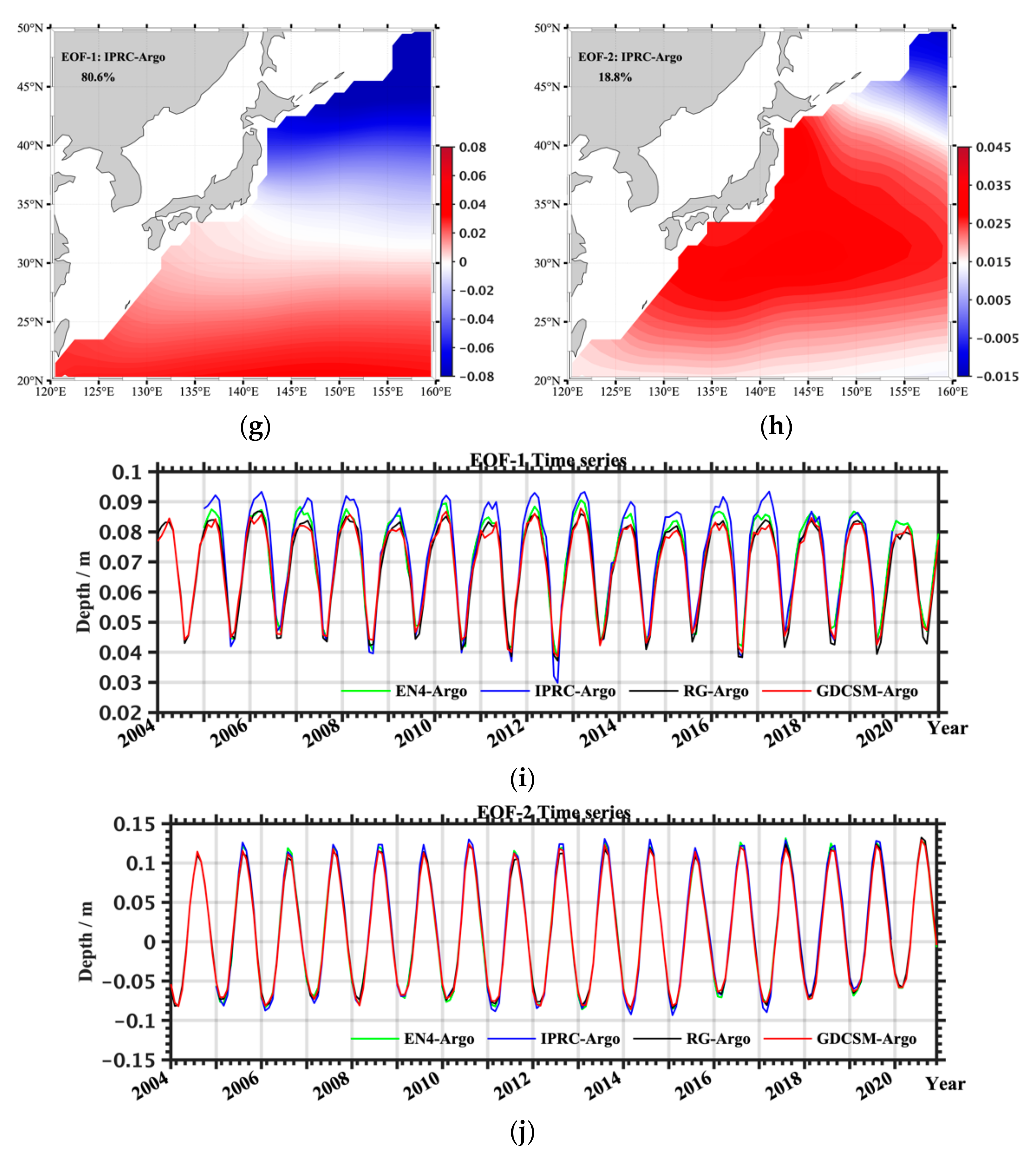
| Temperature RMSE/°C | Salinity RMSE | |||||||||
|---|---|---|---|---|---|---|---|---|---|---|
| 5 m | 10 m | 100 m | 200 m | 500 m | 5 m | 10 m | 100 m | 200 m | 500 m | |
| η = 0.1 | 0.54 | 0.89 | 0.65 | 0.46 | 0.34 | 0.14 | 0.12 | 0.08 | 0.03 | 0.03 |
| η = 0.25 | 0.46 | 0.80 | 0.61 | 0.50 | 0.32 | 0.13 | 0.13 | 0.07 | 0.04 | 0.03 |
| η = 0.5 | 0.45 | 0.73 | 0.60 | 0.45 | 0.26 | 0.12 | 0.11 | 0.07 | 0.04 | 0.03 |
| η = 1.0 | 0.50 | 0.79 | 0.66 | 0.51 | 0.30 | 0.14 | 0.13 | 0.07 | 0.04 | 0.03 |
| η = 2.0 | 0.59 | 0.84 | 0.73 | 0.53 | 0.37 | 0.19 | 0.16 | 0.08 | 0.05 | 0.03 |
| η = 4.0 | 0.66 | 0.92 | 0.79 | 0.59 | 0.40 | 0.23 | 0.18 | 0.09 | 0.05 | 0.04 |
| Dataset Name | EN4-Argo | IPRC-Argo | RG-Argo | GDCSM-Argo |
|---|---|---|---|---|
| Area | 180° W–180° E, 83° S–89° N | 180° W–180° E, 90° S–90° N | 179.5° W–179.5° E, 64.5° S–79.5° N | 179.5° W–179.5° E, 89.5° S–89.5° N |
| Resolution | 1° × 1° | 1° × 1° | 1° × 1° | 1° × 1° |
| Levels | 5–5350 m, 42 levels | 0–2000 m, 27 levels | 2.5–1975 m, 58 levels | 0–1975 m, 58 levels |
| Time | January 1999~December 2021 | January 2005~December 2020 | January 2004~February 2022 | January 2004~December 2020 |
| Observation | WOD05, Argo, GTSPP, ASBO | Argo, Aviso | Argo | Argo |
| Background | Provided by FOAM mode | Provided by mode simulation | Obtained by interpolation | Obtained by interpolation |
| Method | OI | Variation | OI | Gradient-dependent OI |
| Institution | Met Office | International Pacific Research Center | Scripps Institution of Oceanography | Shanghai Ocean University, China Argo Real-time Data Center |
Publisher’s Note: MDPI stays neutral with regard to jurisdictional claims in published maps and institutional affiliations. |
© 2022 by the authors. Licensee MDPI, Basel, Switzerland. This article is an open access article distributed under the terms and conditions of the Creative Commons Attribution (CC BY) license (https://creativecommons.org/licenses/by/4.0/).
Share and Cite
Zhang, C.; Wang, D.; Liu, Z.; Lu, S.; Sun, C.; Wei, Y.; Zhang, M. Global Gridded Argo Dataset Based on Gradient-Dependent Optimal Interpolation. J. Mar. Sci. Eng. 2022, 10, 650. https://doi.org/10.3390/jmse10050650
Zhang C, Wang D, Liu Z, Lu S, Sun C, Wei Y, Zhang M. Global Gridded Argo Dataset Based on Gradient-Dependent Optimal Interpolation. Journal of Marine Science and Engineering. 2022; 10(5):650. https://doi.org/10.3390/jmse10050650
Chicago/Turabian StyleZhang, Chunling, Danyang Wang, Zenghong Liu, Shaolei Lu, Chaohui Sun, Yongliang Wei, and Mingxing Zhang. 2022. "Global Gridded Argo Dataset Based on Gradient-Dependent Optimal Interpolation" Journal of Marine Science and Engineering 10, no. 5: 650. https://doi.org/10.3390/jmse10050650
APA StyleZhang, C., Wang, D., Liu, Z., Lu, S., Sun, C., Wei, Y., & Zhang, M. (2022). Global Gridded Argo Dataset Based on Gradient-Dependent Optimal Interpolation. Journal of Marine Science and Engineering, 10(5), 650. https://doi.org/10.3390/jmse10050650






